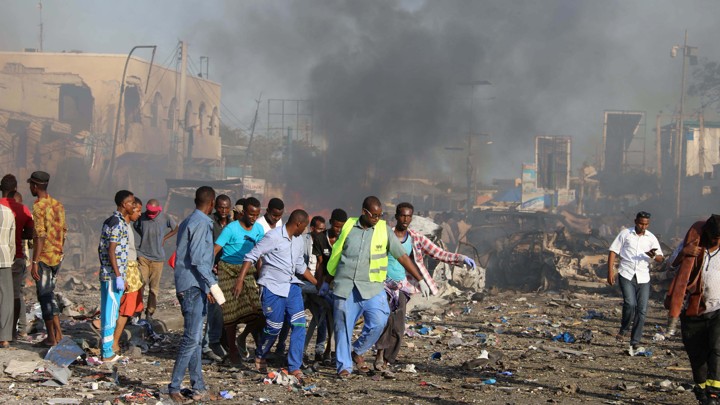By Akanimo Sampson
A rampaging flood has displaced over182,000 people in Somalia, destroyed farmland, infrastructure and roads as well as disrupted livelihoods in some of the worst-hit areas, the Protection Return Monitoring Network (PRMN) of the United Nations High Commissioner for Refugees (UNHCR), has disclosed.
According to the report, in Hirshabelle State, the Shabelle River levels in Belet Weyne town and surrounding areas reached bankfull on October 26, leading to spillage which has submerged the town. Three people, including two children under the age of 10 years, drowned.
Latest reports received on Monday indicated that a boat carrying 20 people capsized in the river in Belet Weyne town. The number of casualties is not yet known as search and rescue for the missing people continues aided by a helicopter provided by the United Nations Support Office in Somalia (UNSOS) at the request of government authorities.
According to PRMN, the majority of the 182,000 people displaced are in Ceel Jaale (162,000).
The road that connects Belet Weyne town and Ceel Jaale, where displaced communities are being relocated, is only passable by heavy trucks. The worst affected areas in Belet Weyne town include Kooshin and Xaawo Taako. In Jowhar and Mahaday Weyne of Hirshabelle State, flooding has damaged large areas of crop land.
River levels in Jowhar are expected to rise in the coming days when the current flood wave in Belet Weyne is transmitted downstream. Nearly 40 river breakage points that were identified and reported by Somalia Water and Land Information Management (SWALIM) last September are likely to escalate the flooding situation.
In Jubaland State, where an estimated 5,300 people have been displaced, the Juba river levels in Baardheere, Dollow, Luuq, and Buale remained high since mid-October causing flooding in the upper reaches.
Bardheere town is the worst affected, with parts of the town inundated. Considering the rainfall forecast, any slight increase in the river level is likely to cause flooding along the entire reach. In Jamame, Jiimey and Sanguuni villages, an unknown number of people living along the Juba river were also displaced by flooding, some of whom moved to Singlayr village.
On October 26, in South West State, local authorities and humanitarian partners informed the Office for the Coordination of Humanitarian Affairs (OCHA), that heavy rains in Berdale district town of Bay and over flow from the Juba River has caused flash flooding affecting an estimated 30,000 people including 12,000 children.
Most of the affected persons have been forced to flee to higher ground in the town after flood waters inundated their homes. Those affected are reportedly in desperate need of clean water, food, temporary latrines and shelter among other immediate needs.
The ongoing rains have already disrupted services by limiting movement, which is also affecting the delivery of supplies to local markets due to impassable roads. Flash flooding in parts of Bay has affected public transport into and out of Baidoa due to impassable roads.
Over 30 trucks loaded with commercial goods destined for surrounding districts are now stranded in the town following the ongoing rains. In the Banadir regionwhere some 3,000 people have been displaced, local authorities and the Internally Displaced Persons (IDPs) leaders reported the destruction of 170 shelters and 210 latrines in Kahda district by heavy rains.
Over 20 IDP settlements were left without latrines after flash floods caused by heavy rains. There are concerns that waste from the destroyed latrines may have leaked into flood water, heightening fears of diseases such as AWD/Cholera.
Humanitarian partners working with national and local authorities have continued to scale–up flood response in affected areas. On October 21, the Federal Ministry of Humanitarian Affairs and Disaster Management, in a statement, called on humanitarian partners to intensify their efforts.
To expedite the response, Prime Minister Hassan Ali Khayre has appointed an inter-ministerial committee to coordinate flood response with state authorities. The committee, which held its first meeting on October 26, is chaired by the Humanitarian Affairs and Disaster Management Minister.
In Hirshabelle State, President Mohamed Abdi Ware established a flood emergency committee to oversee humanitarian response in the state and to coordinate with the national inter-ministerial committee.
Dissemination of early warning information by humanitarians and authorities to people residing in flood prone-area continues and the provision of clean drinking water for 18 days to some 72,000 people in Belet Weyne is underway.
Two mobile health clinics by health partners are operational at Ceel Jaale settlement and humanitarian partners have provided 525 tarpaulin plastic sheets to the most vulnerable groups. More tarpaulin will be delivered in the coming days.
Four boats are currently being used for rescue operation and to reach people in isolated locations but more are required. To improve safety and security, a police post was established at Ceel Jaale location where the majority of the flood-displaced people are settled.
Food for 4,000 families is expected to arrive in Belet Weyne shortly. Water, Sanitation and Hygiene (WASH), health and emergency education are some of the immediate needs. In South West State, WASH and Camp Coordination, Camp Management (CCCM) cluster partners are working with affected and vulnerable communities to improve the drainage system for stagnant water in IDP settlements.
OCHA is working with humanitarian partners and local authorities to minimize the risk of diseases. Authorities have appealed for assistance, mainly emergency shelter kits, mosquito nets, water purification and chlorine tablets and other livelihood support.

